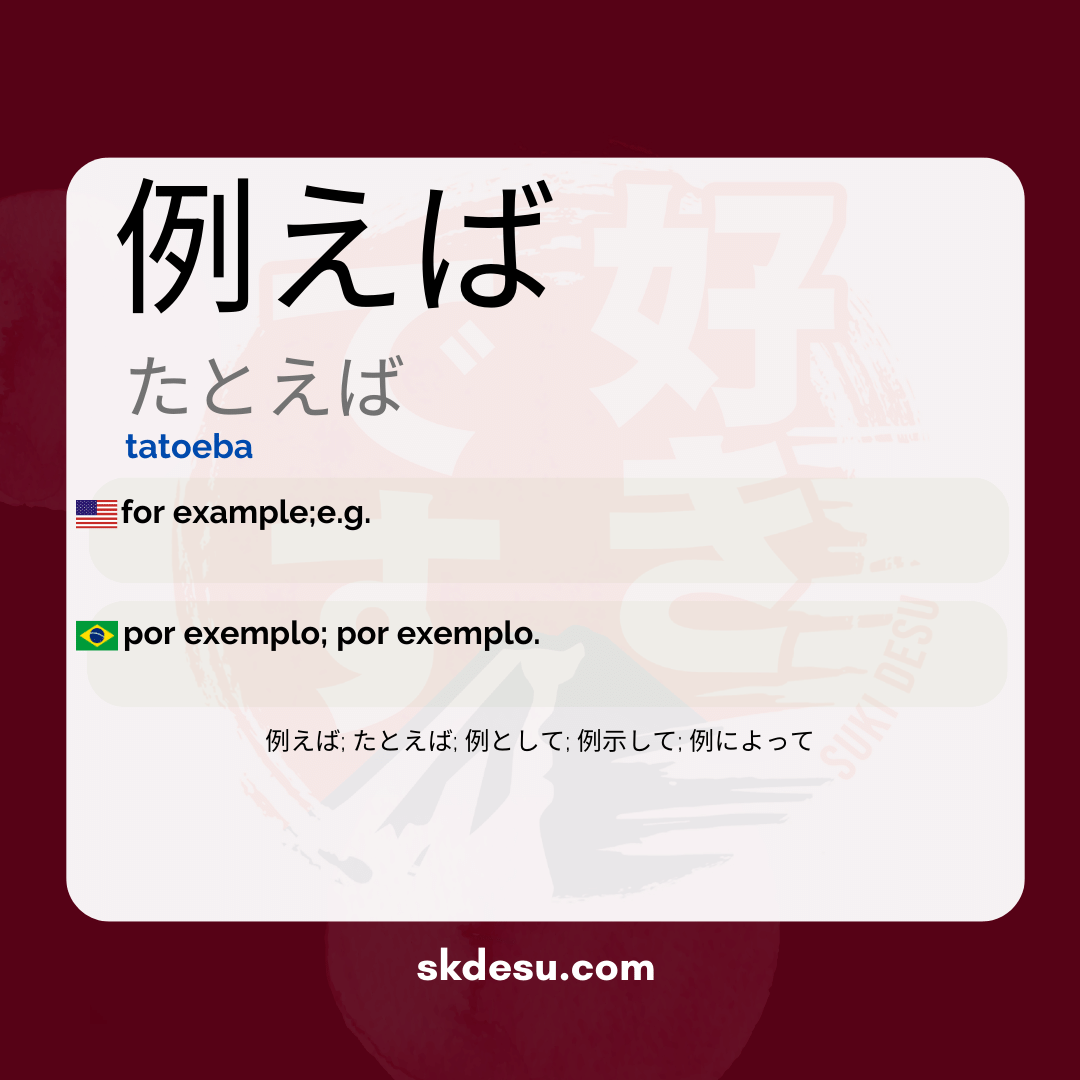Translation and Meaning of: 例えば - tatoeba
If you are learning Japanese, you have probably encountered the word 例えば (たとえば). It is essential for giving examples in conversations, texts, and even formal explanations. In this article, we will explore its meaning, everyday usage, and some curiosities about how this expression appears in Japanese culture. Additionally, you will discover how to memorize it efficiently and avoid common mistakes.
For example, it is one of those words that, even though simple, carries interesting nuances. Whether in everyday dialogues or in animes and dramas, it appears frequently. Here at Suki Nihongo, our detailed dictionary helps you understand not only the translation but also the context behind terms like this. Shall we dive into the details?
Meaning and use of 例えば
例えば means "for example" in English and is used to introduce situations, objects, or ideas that illustrate a point. Unlike the English "for example," which can sound more formal, 例えば is versatile and appears in both casual conversations and academic texts. Its pronunciation, "tatoeba," is easy to remember, making it accessible even for beginners.
An interesting detail is that 例えば usually comes at the beginning of the sentence, followed by a natural pause in speech. For example: 例えば、これはどうですか? (For example, what do you think about this?). This structure is common in explanations and helps to organize the reasoning. If you have watched classes or lectures in Japanese, you have probably noticed its frequent use.
Origin and writing of 例えば
The word 例えば is composed of the kanji 例 (rei), which means "example", and 如 (nyo/jyo), which conveys the idea of "similarity" or "like". Together, they form a term that literally refers to "in the case of an example". Although it may seem complex, its writing is simpler than many might think, especially since the kanji 例 appears in other useful words, such as 例文 (reibun - example sentence).
It is worth noting that 例えば can also be written only in hiragana (たとえば), especially in informal contexts. This flexibility makes it easier for students who have not yet mastered kanji to use it. Interestingly, the kanji version is more common in written texts, while the hiragana form often appears in spoken dialogues or media subtitles.
Tips for memorizing and using 例えば
An effective way to solidify 例えば is to associate it with everyday situations. For example, when studying vocabulary, create sentences like 例えば、猫が好きです (For example, I like cats). Repeating this pattern in different contexts helps to internalize the word. Another tip is to pay attention to how characters in animes or dramas use it – series like "Shirokuma Cafe" or "Terrace House" have dialogues full of natural examples.
Avoid confusing 例えば with expressions like 特に (especially) or つまり (that is), which serve different purposes. While 例えば introduces examples, these other words highlight emphasis or summary. Practicing with gap-fill exercises can be helpful for differentiating them. And if you like flashcards, include 例えば in your review decks in Anki or other apps.
Vocabulary
Expand your vocabulary with related words:
Synonyms and similar words
- 例えば (tatoeba) - For example
- 例として (reitoshite) - Como exemplo
- 例示して (reiji shite) - Ilustrando
- 例によって (rei ni yotte) - Depending on the example
Romaji: tatoeba
Kana: たとえば
Type: adverb
L: jlpt-n4
Translation / Meaning: for example; for example.
Meaning in English: for example;e.g.
Definition: 1. Love: Deep compassion and love for others and things. 2. Happiness: Being a pleasant feeling or state. 3. Courage: Strong will and determination to face difficulties and dangers.
Quick Access
- Vocabulary
- Writing
- Sentences
How to Write in Japanese - (例えば) tatoeba
See below a step-by-step guide on how to write the word by hand in Japanese. (例えば) tatoeba:
Example Sentences - (例えば) tatoeba
See below some example sentences:
Nenhum resultado encontrado.
Other Words of this Type: adverb
See other words from our dictionary that are also: adverb

